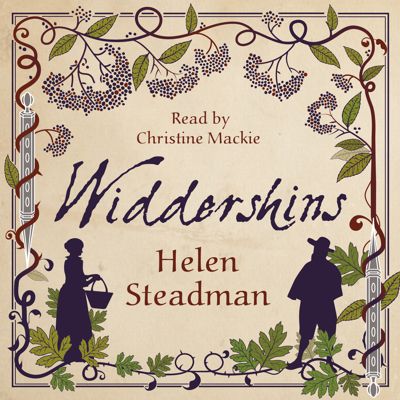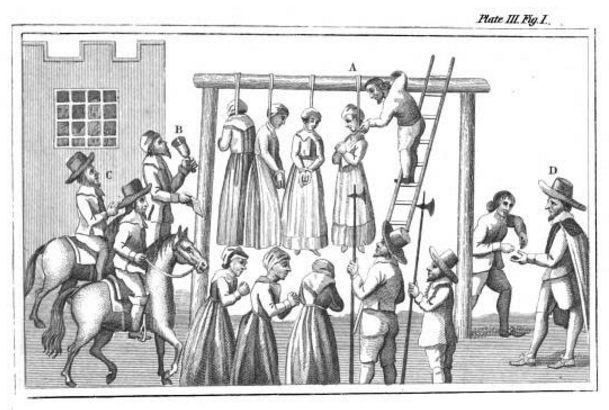
The new audio book of Widdershins is narrated brilliantly by talented actor, Christine Mackie, from Downton Abbey, Coronation Street, Wire in the Blood, and so on.
The first part of a two-part series, Widdershins is inspired by the Newcastle witch trials, where 16 people were hanged. Despite being the largest mass execution of witches on a single day in England, these trials are not widely known about. In August 1650, 15 women and one man were hanged as witches after a Scottish witchfinder found them guilty of consorting with the devil. This notorious man was hired by the Puritan authorities in response to a petition from the Newcastle townsfolk who wanted to be rid of their witches.
Widdershins is told through the eyes of Jane Chandler, a young woman accused of witchcraft, and John Sharpe, the witchfinder who condemns her to death. Jane Chandler is an apprentice healer. From childhood, she and her mother have used herbs to cure the sick. But Jane soon learns that her sheltered life in a small village is not safe from the troubles of the wider world. From his father’s beatings to his uncle’s raging sermons, John Sharpe is beset by bad fortune. Fighting through personal tragedy, he finds his purpose: to become a witchfinder and save innocents from the scourge of witchcraft.
Witchfinders – how much of a motivating factor was money?
Thanks very much for inviting me along to guest post on your blog today. My historical novels Widdershins and its sequel, Sunwise, were inspired by the Newcastle witch trials in 1650 when sixteen people were executed for witchcraft on the same day. Now, Christine Mackie of Downton Abbey fame has brought the Newcastle witch trials to life as audiobooks.
It’s odd that the Newcastle witch trials are not widely known about when they resulted in the biggest mass execution of witches on a single day in England. The 1612 Pendle witch trials are very well known, and ten people were executed on Gallows Hill in Lancashire. At the 1645 Chelmsford witch trials, nineteen people were executed in all; however, these executions did not take place on the same day, or in the same town. That said, Chelmsford and Essex more widely suffered terribly under witch trials, not least because Essex was the main stamping ground of the Witchfinder General, Matthew Hopkins.
There is a well-known picture, which is often used to illustrate witch trials, but it’s not usually recognised that this illustration represents the Newcastle witch trials. It appears in Ralph Gardiner’s 1655 book about the Newcastle coal trade, England’s Grievance Discovered.

The plate shows the witchfinder on the right receiving his pay, and on the left is the bell ringer who accompanied him around Newcastle, encouraging people to send out their witches. It’s interesting that the artist has chosen to show the witchfinder receiving his money, rather than, say, testing witches. Clearly, almost four hundred years ago, people suspected witchfinding was no more than a money-making venture, albeit one that cost many people their lives.
Following a petition from the townspeople, the Common Council of Newcastle sent to Scotland for a witchfinder. In perhaps the earliest incidence of local authority performance-related pay, the council paid the witch-finder twenty shillings per witch. So it’s no wonder he put thirty people on trial and found twenty-seven of them guilty. (That is, until he was revealed as a fraud and thrown out of town, but not before sixteen people were hanged.) It’s quite sobering to see the witch trial fees listed in the Newcastle Chamberlain’s Accounts amongst more mundane items such as wine supplies and grazing fees.
When the Scottish witch-finder fled Newcastle following the trials, an eye-witness, John Wheeler, stated that he went ‘went into Northumberland, to try women there, where he got of some three pound a-peece’. According to Wheeler, Henry Ogle a former MP seized him, but the witch finder got away again, this time mostly likely back to his native Scotland, where it seems prices were even higher.
In Scotland, there is a record of John Kincaid, a well-known Scottish witchfinder being paid six pounds for ‘brodding’ (pricking) a woman called Margaret Denham at Burncastle near Lauder. In addition to this eye-watering fee, he charged a further four pounds for ‘meat and drink and wyne’. Two men were also paid an astonishing forty-five pounds for guarding her for a month. Even after these exorbitant fees, the unfortunate woman still left sixty-five pounds following her death, which makes me wonder whether she was targeted for her wealth.
As part of the research for my novels, I read the diaries of two of the better known witchfinders in England: Matthew Hopkins and John Stearne. These diaries are filled with fascinating (if troubling) insights into what might go through the mind of a man determining whether someone should live or die on a charge of witchcraft.
In his short book, Hopkins sets out fourteen questions and replies to them. These questions range from whether he is a witch himself, through to whether witchfinders are simply fleecing people. Hopkins at first appears to be rather cheaper than the Scottish witchfinders as he humbly states that he charged only twenty shillings per town. This seems to be excellent value compared with the Newcastle witchfinder’s fee of twenty shillings per witch, and John Kincaid’s eyewatering fee of six pounds for one witch in Scotland.
However, Hopkins’ claims need to be taken with a large pinch of salt. Aldeburgh was one of the locales using Hopkins’ witchfinding services. It spent over one-seventh of its annual budget on the Witchfinder General and had to levy a special tax to raise money, which gives lie to Hopkins’ claim to charge only twenty shillings per town.
If you’re interested in the English witch trials, it’s worth reading Matthew Hopkins’ diary, and that of his sidekick, the pricker, John Stearne. The title of Hopkins’ diary reveals something of his character. As well as styling himself the Witchfinder General, he feels that his diary will benefit the whole kingdom, so being humble isn’t one of his faults. What both of these diaries have in common is that they reveal a chilling insight into the minds of two men responsible for the death of large numbers of women, often relying on confessions gained under torture, and on grounds as thin as women giving their pets odd-sounding names like Vinegar Tom.
Sources
Hugo Arnot’s Criminal Trials, appendix, in J. Sands (1881) Sketches of Tranent in the Olden Time, Chapter 3 ‘Witchcraft, 1591’.
Ralph Gardiner (1849 [1655]) England’s Grievance Discovered in Relation to the Coal Trade. North Shields: Philipson and Hare. Ch. 53.
Matthew Hopkins (2010) [1647] The Discovery of Witches in Answer to Severall Queries, Lately: Delivered to the Judges of Assize for the County of Norfolk and Now Published by Matthew Hopkins, Witch-finder, for the Benefit of the Whole Kingdome. Qontro Classics
John Stearne (1973) [1648] A Confirmation and Discovery of Witch Craft. The Rota.
Universal eBook link: https://books2read.com/u/boa6VR
Amazon UK: https://www.amazon.co.uk/Widdershins/dp/B097TZ2KQB
Amazon US: https://www.amazon.com/Widdershins/dp/B097WF4YXN
Amazon CA: https://www.amazon.ca/Widdershins-Helen-Steadman-ebook/dp/B0848N433L
Amazon AU: https://www.amazon.com.au/Widdershins/dp/B097WP1F6Q
Audible Link: https://bit.ly/WiddershinsAudio
Blackwells: https://blackwells.co.uk/bookshop/product/Widdershins-by-Helen-Steadman-author/9781911293040
Waterstones: https://www.waterstones.com/book/widdershins-widdershins-1/helen-steadman/9781911293040
Kobo: https://www.kobo.com/gb/en/ebook/widdershins-20
iBooks: https://books.apple.com/gb/author/helen-steadman/id1245484068
iTunes: https://books.apple.com/gb/author/helen-steadman/id1245484068
Foyles: https://www.foyles.co.uk/witem/fiction-poetry/widdershins-(widdershins-1),helen-steadman-9781911293040
Book Depository: https://www.bookdepository.com/Widdershins-Widdershins-1-Helen-Steadman/9781911293040
Meet Helen Steadman

Dr Helen Steadman is a historical novelist. Her first novel, Widdershins and its sequel, Sunwise were inspired by the Newcastle witch trials. Her third novel, The Running Wolf was inspired by a group of Lutheran swordmakers who defected from Germany to England in 1687.
Despite the Newcastle witch trials being the largest mass execution of witches on a single day in England, they are not widely known about. Helen is particularly interested in revealing hidden histories and she is a thorough researcher who goes to great lengths in pursuit of historical accuracy. To get under the skin of the cunning women in Widdershins and Sunwise, Helen trained in herbalism and learned how to identify, grow and harvest plants and then made herbal medicines from bark, seeds, flowers and berries.
The Running Wolf is the story of a group of master swordmakers who left Solingen, Germany and moved to Shotley Bridge, England in 1687. As well as carrying out in-depth archive research and visiting forges in Solingen to bring her story to life, Helen also undertook blacksmith training, which culminated in making her own sword. During her archive research, Helen uncovered a lot of new material and she published her findings in the Northern History journal.
Helen is now working on her fourth novel.
Connect with Helen
Website: https://helensteadman.com/
Twitter: https://twitter.com/hsteadman1650
Facebook: https://www.facebook.com/helensteadmanauthor
Instagram: https://www.instagram.com/helensteadmanauthor/
Amazon Author Page: https://www.amazon.com/Helen-Steadman/e/B076P4VRJD
Goodreads: https://www.goodreads.com/author/show/2297484.Helen_Steadman
YouTube: https://www.youtube.com/channel/UCHQ6GYusuraZF3fb-sLWx2Q
Meet Narrator Christine Mackie
Christine Mackie has worked extensively in TV over the last thirty years in well-known TV series such as Downton Abbey, Wire in the Blood, Coronation Street, French & Saunders and The Grand. Theatre work includes numerous productions in new writing as well as classics, such as A Midsummer Night’s Dream, Comedy of Errors, Richard III, An Inspector Calls, and the Railway Children. In a recent all women version of Whisky Galore, Christine played three men, three women and a Red Setter dog!
Social Media Links:
IMDB for Christine Mackie: https://www.imdb.com/name/nm0533499/
Thanks very much for hosting today’s stop on the Widdershins audiobook blog tour, Mercedes. Much appreciated 🧙♀️🧡🧙♀️
Thank you for hosting today’s blog tour stop!